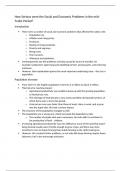How Serious were the Social and Economic Problems in the mid-
Tudor Period?
Introduction
There were a number of social and economic problems that affected the nation, like:
o Population rise.
o Inflation and rising prices.
o Enclosure.
o Decline in living standards.
o Poverty and vagrancy.
o Rising rents.
o Poor harvests.
o Influenzas and epidemics.
Contemporaries saw the problems as being caused by issues of morality, for
example, landowners oppressing and exploiting farmers and peasants, and enforcing
enclosure.
However, their explanation ignores the most important underlying issue – the rise in
population.
Population Increase
From 1525-51, the English population rose from 2.3 million to about 3 million.
This had a far-reaching impact:
o Agricultural productivity was unable to keep up with the growing population,
so food prices rose.
o This shortage of food became a very serious problem during bad harvests, of
which there were a lot in this period.
o Grain prices rose even faster than those of meat, dairy or wool, and as gran
was the staple diet, this had a serious impact.
The structure of the population changed as well.
The population was a young one, which increased the dependency ratio.
o The number of people who were consumers, but who didn’t contribute to
the production of food – children.
Increasing agricultural productivity was very difficult as much of the land that wasn’t
being farmed usually wasn’t fertile enough to grow crops, and there was more
incentive to turn to sheep farming than arable farming as the cloth trade grew.
However, this created further problems, as not only did sheep farming require fewer
labourers, but it also encourage enclosure.
, Rising Prices and Rent
Although prices had been rising steadily from the start of the 1500s, 1540 saw a
dramatic increase.
This was largely due to Henry VIII debased the coinage to pay for his war with France
and Scotland.
This led to inflation, and wages couldn’t keep up with the rising prices.
As a result, many peasants found themselves in poverty, and estimates suggest that
over half the population was unable to support itself.
This situation was made worse by bad harvest which drove food prices up even
more.
The Impact of the Dissolution of the Monasteries and Enclosure
The monasteries had provided the poor aid, and their dissolution meant that there
was no support these people.
Enclosure didn’t help, as it worsened unemployment.
The matter was made worse by the depression in the cloth trade.
As such, many people became vagrants and turned either to criminality or begging.
As they lacked a police force, the government was forced into harsh measures to
prevent such groups becoming involved in the unrest.
As such, the 1547 vagrancy act was passed, that meant beggars were condemned to
2 years of slavery for a first offence, and life for a second.
In what Ways did the Social and Economic Problems Contribute to Unrest?
The government’s response to the social problems was also important in provoking
unrest.
In order to finance the war with Scotland, Somerset continued a policy of
debasement, which resulted in inflation rising even faster.
Many of the commons believed that it was the greed of the landowners that was
causing inflation, and that enclosure was symptomatic of that greed.
Somerset established commissions in both 1548 and 1549 to look into the problem
of enclosure.
The achievements of this project were limited, as landowners blocked any attempt
to legislate on the issue, forcing somerset to issue proclamations to force
landowners to reverse their policy.
This lost him support amongst the landowners, who believed he was too
sympathetic to the lower orders, but the lower orders saw him as their champion.
Therefore, when legislation failed, they often took the law into their own hands and
threw down what they considered to be illegal enclosures, believing that Somerset
would support their actions.
Why was there so much Unrest in 1549?




